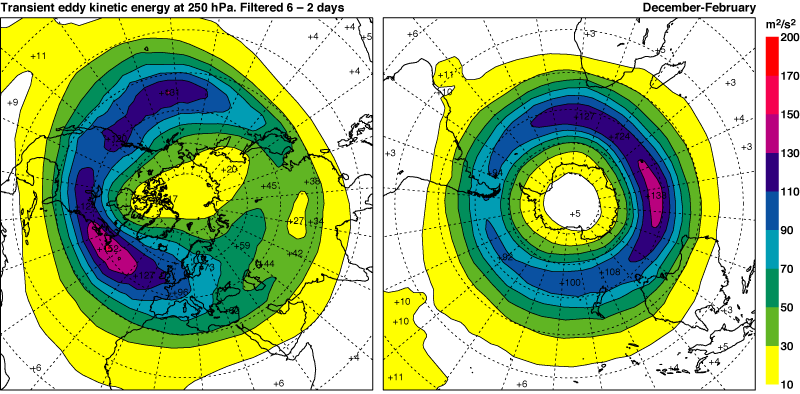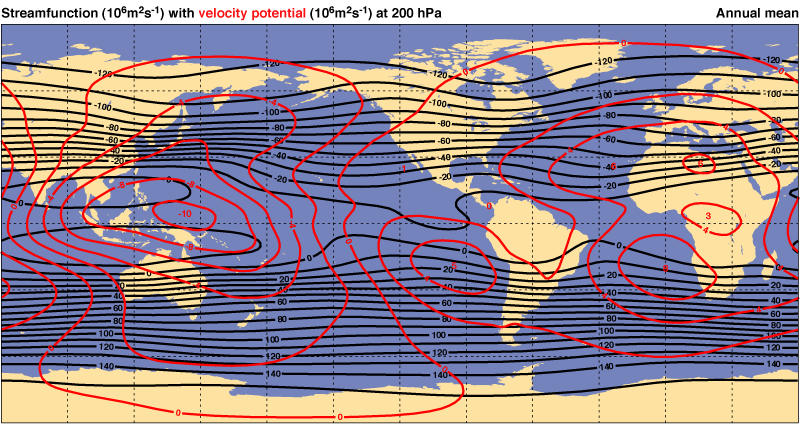Climate Dynamics 753
The General Circulation of the Atmosphere
George Mason University
| DJF kinetic energy [2-6 day time scales] 250hPa |
Heating in Θ [isentropic] Coord. |
Circulation at 200 hPa ψ and χ |
 |
 |
 |
Figures Courtesy of European Center for Medium Range Weather Forecasts
Kallbert, P. P. Berrisfort, B. Hoskins, A. Simmons, S. Uppala, S. Lamy-Thepaut and
R. Hine, 2005. ERA-40 Atlas. ERA-40 Project Report Series No. 19
Course Syllabus Fall 2024
http://mason.gmu.edu/~dstraus/CLIM_753_syllabus.htm
Course Instructor: David M. Straus
(Department of Atmospheric, Oceanic and Earth Sciences)
Instructor Contact:
David Straus Office Hrs Tue-Thur 11AM-12PM or by arrangement
dstraus@gmu.edu
Class location: Research Hall 121
Class time: Tues and Thurs 12:00 PM to 1:15 PM
- First class: Tues Aug 27
- Classes on Tues Sep 10 and Thurs Sep 12 will be Zoom
- Classes on Tues Sep 17 and Thurs Sep 19 will be taught by Erik Swenson
- No class Tues Nov 5 (Election Day) and Thur Nov 28 (Thanksgiving)
- Last class: Thurs Dec 5
- Final Exam: Thurs Dec 12 (10:30 AM - 1:15 PM)
Course Goals and Student Learning Outcomes
- Acquire knowledge of the basic components of the observed atmospheric circulation.
- Understand the role of different circulation components in transporting energy and momentum.
- Be able to articulate the ways in which the general circulation relates weather phenomena to the climate.
- Become familiar with the application of the mathematical theories to the observed circulation.
- Acquire basic skills for carrying out original research on the general circulation.
- Develop the ability to read current journal papers on the subject, and report the main findings.
Student Work Components
- Homework Sets = 33% percent of grade
- Mid-Term and Final Exams = 33% percent of grade
- Project = 33% of grade
Primary Required Reading
- Course Notes Available vis Blackboard
Optional Supplementary References:
- Andrews D.G., J.R. Holton and C.B. Leovy. Middle Atmosphere Dynamics. Academic Press, 1987.
- Wallace J.M. and co-authors. The Atmospheric General Circulation. Cambridge University Press, 2023.
- Randall, D. An Introduction to the Global Circulation of the Atmosphere.. Princeton University Press, 2015.
- Masaki, Satoh. Atmospheric Circulation Dynamics and General Circulation Models. Springer, 2004.
- Salby, Murry L. Fundamentals of Atmospheric Physics. Academic Press, 1996.
Course Topics
- Introduction to the Circulation
- The Mean Meridional Circulation: Hadley and Ferrel Cells
- Relationship Between Microscopic and Macroscopic Properties of Air: Fundamental Results from Physics
- Stationary waves: Introduction and Observations.
- Theory of Zonal Propagation of Rossby Waves.
- Theory of Vertical Propagation of Rossby waves.
- Theory of Zonal and Meridional Propagation of Rossby Waves.
- Mid-latitude Transient Fluctuations.
- Global Energy and Enthalpy Transport.
- Available Potential Energy.
- Angular Momentum Transport.
- Life cycles of Baroclinic Instability.
- Advanced Statistical Description of Mid-Latitude Transient Fluctuations.
- Introduction to Equatorial Waves.
- Simple theory of Forced Tropical Stationary Waves.
- Interactions between the Eddies and the Zonal Flow.
- Introduction to Global Scale Interactions and the atmospheric spectrum.
Some Topics for Projects
- The Quasi-Biennial Oscillation
- Introduction to the Stratospheric Circulation: Sudden Warmings
- The mean meridional circulation in the stratosphere: Brewer-Dobson Circulation.
- Preferred and Persistent States in the Atmosphere: Teleconnections.
Academic Integrity
The homeworks and are designed to be undertaken independently.
You may discuss your ideas with others and conference with peers on drafts of the work.
However it is not appropriate to give your paper to someone else to revise.
You are responsible for making certain that there is no question that the work you hand in is your own.
If only your name appears on an assignment,
your professor has the right to expect that you have done the work by yourself, fully and independently.
The course projects may be done in teams, but it should be made very clear to the professor and the rest of the
class what the responsibility of each student was.
Please see the
_University Honor Code
and _Common Course Policies





